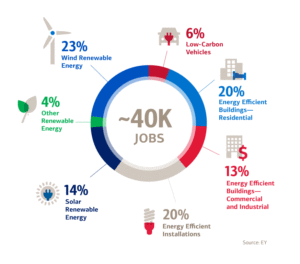For the past few months, we’ve been regularly highlighting some of the efforts being made among the nation’s businesses to adopt clean energy solutions, particularly those who have pledged to become “100 percent renewable” as members of the RE100 group. This week, let’s take a look at Bank of America, which is among those ranks as it has set a goal to become carbon neutral and purchase 100 percent renewable electricity by 2020.
Streamlining Its Global Operations
The bank’s plan is to work to reduce its location-based greenhouse gas emissions by 50 percent, energy use by 40 percent, and water use by 45 percent in its operations across the globe.
It has already made significant progress. Between 2010 to 2015, Bank of America reduced its greenhouse gas emissions by 37 percent through efforts like energy efficiency projects, consolidating space, and leveraging a less carbon-intensive grid. To achieve carbon neutrality, the bank will continue to scale its energy efficiency and conservation efforts, purchase 100 percent renewable electricity, and utilize carbon offsets.
Environmental Financing
The bank has also pledged to contribute $125 billion to accelerate the transition to a low-carbon economy through lending, investing, capital raising, advisory services and developing financing solutions for clients around the world; in 2017 alone, they provided $17 billion toward these activities.
From 2013-2016, Bank of America’s environmental financing supported an average of 39,728 domestic jobs annually. This includes employment in industries such as wind, solar, energy conservation and energy efficiency.
Most recently, Bank of America issued a $2.25 billion green bond, making it the first U.S. financial institution to issue four corporate green bonds, which now total $4.35 billion for renewable energy projects since 2013. This type of bond is important to establish business certainty for investors looking to back clean energy.
Charitable Campaigns
Furthermore, Bank of America has a successful charitable foundation. Among its recent clean energy initiatives, it provided a $500,000 grant to GRID Alternatives, which works to make affordable solar power and solar jobs accessible to low-income individuals. The program itself is a job creator, supporting up to 60 GRID SolarCorps Fellows to participate in hands-on training to jumpstart their own clean energy careers while increasing access to solar power and job training in underserved communities.
And in March, the foundation joined the U.S. Green Building Council (USGBC) to launch a new grant program designed to recognize the sustainability and green building achievements of U.S. cities pursuing Leadership in Energy & Environmental Design (LEED) certification. Each grant will consist of financial assistance to aid in the pursuit of a LEED for Cities certification, educational resources, and customized technical support.
What’s perhaps most impressive about Bank of America’s commitments to clean energy is the myriad of ways they are approaching the issue. CRES thanks the company for making a difference and setting a precedent for other financial institutions pursing clean energy goals.

